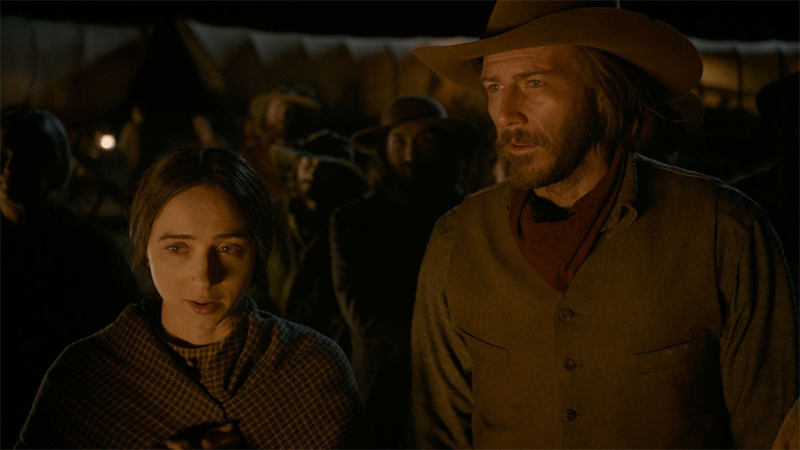The Ballad of Buster Scruggs
Dec 5, 2018
The Ballad of Buster Scruggs is ‘œCoen Brothers 101,’ a kind of all-purpose primer for everything Joel and Ethan Coen. An anthology of folkloric vignettes set against the backdrop of the Old West, each widely disparate, self-contained story is a reflection of some facet of the Coens’ long and curious career as outsiders-on-the-inside filmmakers who have relentlessly refused to play by any rules but their own. They have spent the past three and a half decades banging back and forth among all of Hollywood’s most cherished genres, wildly and irreverently reinventing them within the rhetoric of their own unique cinematic language, and Buster Scruggs plays like a Greatest Hits package. It starts with the farcical slapstick of Raising Arizona (1987) and O Brother, Where Art Thou? (2000), downshifts to the brutal, Hobbesian ironies of Blood Simple (1984), Fargo (1996), and No Country for Old Men (2007), shifts over to the straightforward drama and suspense of True Grit (2010), and then ends on the vaguely supernatural fatalism of A Serious Man (2013).
The constant in the film, like virtually all of the Coens’ works, is violence, which they paint with virtually every brush imaginable, from the comical, to the satirical, to the simply brutal (the film could literally be read as a treatise on the visual, tonal, and thematic flexibility of screen bloodshed). Each story hinges in some way or another on the inevitability of death, and characters meet their maker in supremely violent fashion; no one goes softly into that good night, although one character ascends to heaven with wings, strumming a harp like the he stopped by from an old Looney Tunes cartoon.
The Coens structure the storytelling as if we were reading six stories from a late 19th-century clothbound anthology titled The Ballad of Buster Scruggs and Other Tales of the American Frontier. The film opens with the book sitting on a table, and the hand of an unseen man opens it and turns the pages, allowing us to see the title page, table of contents, and the color plates that precede each story, all protected by onion skin parchment. Like George A. Romero and Stephen King’s Creepshow (1982), part of the film’s pleasure is its evocation of an older storytelling medium through cinematic language (where Romero used comic book panels and garish lighting to suggest old EC comics from the ’50s. the Coens return at the end of each vignette to the physical book, which suggests the old Pecos Bill anthologies from the turn of the 20th century, which similarly professed to be genuine folklore, but were not).
The film opens with a direct nod to the venerable John Ford via its familiar view of Monument Valley, as we are introduced to the titular Buster Scruggs (Tim Blake Nelson), a singing cowboy with delightfully square teeth, impossibly clean white duds, and an amusingly broad vocabulary (which includes inspirit, appellations, cognomens, gullet, in fettle, aspersin’, sobriquet, Archimedean, mellifluous, and ramified). He seems like a genial yokel, but as he tells a surly bartender, ‘œDon’t let my white duds and pleasant demeanor fool you, for I too have been known to violate the statutes of man.’ In other words, he’s a vicious killer, albeit one who puts bullets through men’s foreheads with a cordial grin and only when threatened. Scruggs’s story is something of a one-note joke, with Nelson mugging his way through the Old West as if Gene Autry had stumbled into a Sergio Leone spaghetti western.
None of the subsequent stories are as directly comical as ‘œBuster Scruggs,’ as the Coens focus more on bitter irony and demystification. ‘œNear Algodones’ is a bit of surly black comedy featuring a would-be bank robber (James Franco) who regularly finds himself on the receiving end of a hangman’s noose, while ‘œMeal Ticket’ has Liam Neeson playing a shady impresario who earns money with a travelling show that features an armless and legless man (Harry Melling) reciting famous oratories to crowds that grow noticeably sparser at each stop. In each of these stories, the ultimate lesson is that life is cheap, as Franco’s robber is quickly sentenced to death multiple times in a farce of justice, while Melling’s artist can be replaced by a chicken who can supposedly do math problems. The next two stories, ‘œAll Gold Canyon’ and ‘œThe Gal Who Got Rattled,’ play as relatively straightforward dramas about dreams turning into disasters. In the former (which is loosely based on a Jack London story), Tom Waits plays a grizzled prospector who doesn’t take well to betrayal by a younger man, and in the latter (which is based on a story by Stewart Edward White) Zoe Kazan plays a young woman on a wagon train to Oregon whose enterprising older brother dies, leaving her alone and in debt. Things seem grim until a well-meaning trail hand (Bill Heck) offers marriage, but as we probably know by now, something tragic is just waiting to unfold. And, finally, ‘œThe Mortal Remains’ takes the film into heavy, metaphysical territory with a quartet of unlikely riders (a morally righteous prig, two bounty hunters’”one English and one French’”and a trapper) on a stagecoach debating morality and religion as they head to an unknown fate.
Although the entire film was shot by French cinematographer Bruno Delbonnel (a favorite of Jean-Pierre Jeunet and, more recently, Tim Burton’s, who previously worked with the Coens on 2013’s Inside Llewyn Davis), the style of each vignette is distinctly different. ‘œThe Ballad of Buster Scruggs,’ for example, has the distinctly unrealistic look of something shot entirely on sets with rear projection, while ‘œThe Gal Who Got Rattled’ has a traditional classical Hollywood realism and ‘œThe Mortal Remains’ evokes a Hammer horror film with its intense primary hues of blue and red. As an anthology film, The Ballad of Buster Scruggs is inherently uneven, with some stories playing better than other (although one’s personal taste will also inevitably play a significant role). The ‘œBuster Scruggs’ vignette establishes a lanky comic tone that the rest of the film largely discards, although I found it one of the most enjoyable. I was alternately moved, perplexed, and shocked by ‘œThe Gal Who Got Rattled,’ which uses a droll comic undertone as a means of distracting us from the story’s inevitable march toward tragedy. ‘œThe Mortal Remains’ is in some ways the most ambitious, but also the least satisfying piece, which, as the concluding vignette, makes the film as a whole feel more underwhelming than it actually is. The Ballad of Buster Scruggs is, if anything, testament to the Coens’ far-flung sensibilities and their persistent agility in wringing comedy, pathos, and irony from the most well-worn of genre conventions, respecting them while also gleefully dismantling them.
Copyright © 2018 James Kendrick
Thoughts? E-mail James Kendrick
All images copyright © Netflix



